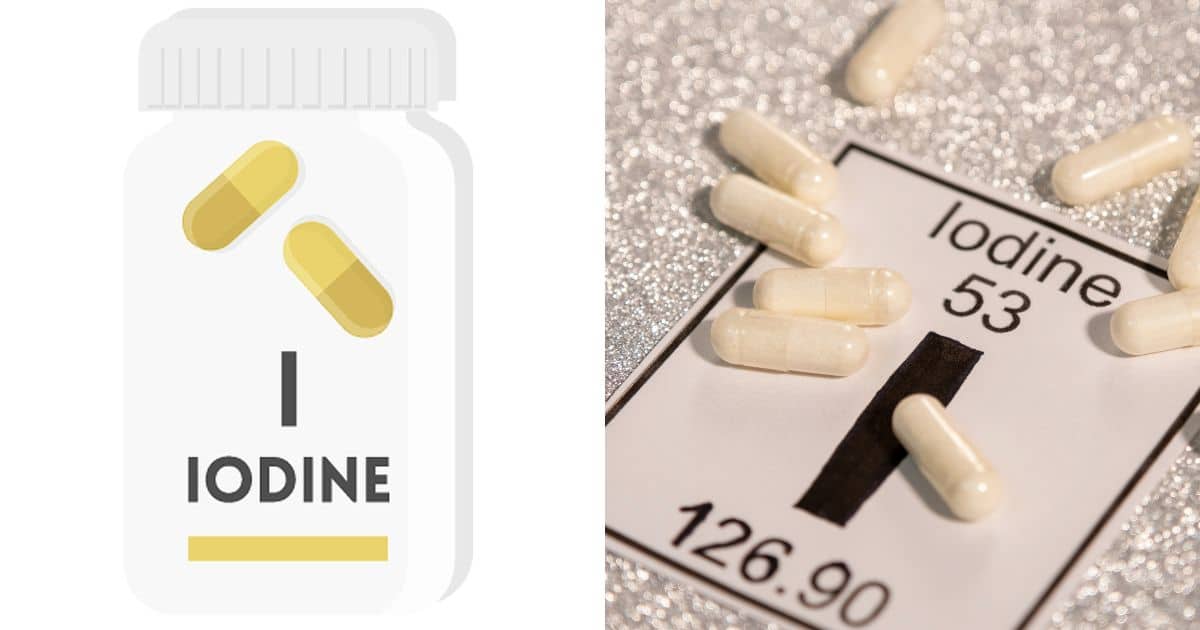I am taking 2-6 drops of 2.2% Lugols daily... usually 5 drops... think that might be too much? I am having bad side effects weakness, lightheadedness, stomach trouble, hair loss... thought it was from 4 weeks on TRT 100mg/wk split pins... I wonder if the Lugols is effecting the TRT or causing the sides by itself...? I see a Endocrine Doc nest week... guess I'll stop the Lugols until he checks levels and advises me... I wonder if Japanese really do have different genes in processing high amounts of iodine...large amounts of iodine block the thyroid's ability to make thyroid hormones
:max_bytes(150000):strip_icc()/155298266-56a955873df78cf772a5f89a.JPG)
Iodine's Role in Thyroid Health
Iodine is required for the thyroid gland to produce thyroid hormones. Since the body doesn't make iodine on its own, it needs to come from your diet.www.verywellhealth.com
You are using an out of date browser. It may not display this or other websites correctly.
You should upgrade or use an alternative browser.
You should upgrade or use an alternative browser.
does Iodine influence hormone receptor activity?
- Thread starter Gianluca
- Start date
-
- Tags
- hormone receptors iodine
Vince
Super Moderator
Conclusions
It is axiomatic that there are no uncomplicated issues in the field of diet and health – and the subject of iodine is no exception. What conclusions can we draw from these conflicting assertions about iodine, especially supplementation containing iodide?
Let’s start by looking at the RDI of 100-150 mcg iodine per day. Most would argue that this intake is too low. Yet it is in line with what Weston Price reports in primitive diets. In preliminary analyses, he found a range of 24-32 mcg daily for the northern American Indians and 131-175 daily for the Inuit.29 Apparently the Inuit of the far north do not eat seaweed.30 Unfortunately, Price did not carry out more extensive measurements, especially among those he reported to eat seaweed—the Gaelic peoples of the Outer Hebrides and the Andean Indians of Peru.
It appears to be very difficult to estimate the iodine intake in diets that contain seaweed. Based on the reported values in seaweed, some have claimed levels of 12 mg (12,000 mcg) in Japanese diets,31 leading Abraham and Brownstein to propose that “only mainland Japanese consume adequate amounts of iodine and that 99 percent of the world population are deficient in inorganic, non-radioactive iodine; that is, they have not reached whole body sufficiency for that essential element.”32
However, a published analysis of iodine intake in Japan found a range of 45-1921 mcg per day,33 and Weston Price found healthy peoples consuming iodine amounts in the lower end of this range. Furthermore, without seaweed, it would be very difficult to exceed 1,000 mcg per day, based on values found in typical traditional foods (see chart, page 47). For example, one meal of cod, one meal of shellfish including the 20 grams of the hepatopancreas, and one meal of mussels, plus additional meat, vegetables and legumes would supply about 1,000 mcg iodine; diets based on meat, even organ meats, would supply considerably less.
The late distinguished researcher Emmanual Cheraskin and his colleagues conducted a survey of reported total number of clinical symptoms and signs (as judged from the Cornell Medical Index Health Questionnaire) and correlated the findings with average iodine consumption. An intake of approximately 1,000 mcg per day correlated with the lowest number of reported symptoms, that is, the highest level of health.34
Abraham and Brownstein argue that the human iodine requirement is 1,500 mcg per day (1.5 mg) which is difficult to achieve without using seaweed, iodized salt or supplementation. They argue that because of widespread bromide and fluoride toxicity, most people today require between 5 and 50 mg per day, amounts only possible with supplementation; they do note that such supplementation should only be taken under the supervision of a physician to monitor iodine status.35
We cannot ignore the many reports of improved health using various types of iodine supplementation—whether through tincture of iodine on the skin, the atomidine protocol recommended by Edgar Cayce or use of iodine/potassium iodide compounds as proposed by Drs. Abraham and Brownstein. Increased exposure to goitrogenic mercury, bromides and fluoride compounds, and soy products ubiquitous in the food supply, coupled with declining levels of thyroid-supporting nutrients such as selenium and vitamin A in modern diets, may explain why some people need much higher levels of iodine than those found in traditional diets. Dr. Brownstein is to be credited with alerting the public to the dangers of bromides increasingly used in processed foods, sodas, vegetable oils, breads and even replacing iodine in teat washes for dairy cows, as well as in thousands of consumer products.
The Abraham protocol does carry a risk of adverse reactions and should be carried out under the supervision of a physician with experience in using it. As these physicians point out, consuming iodine in milligram doses should be coupled with a complete nutritional program that includes adequate amounts of selenium and magnesium, and, they claim, omega-3 fatty acids, and with careful supervision of detoxing reactions. According to Dr. Brownstein, chloride increases renal clearance of bromide and the use of salt or ammonium chloride shortens the time required for bromide detoxification. He recommends oral administration of sodium chloride (6-10 gm per day) or intravenous sodium chloride for increasing the renal clearance of bromide.31
Dr. Gaby’s call for a careful study should not be ignored. Not every physician reports the sterling results described by doctors using the Abraham protocol, and some individuals—including this author—have experienced adverse reactions to Lugol’s solution. The study should include a control group and groups using other iodine therapies, such as tincture of iodine on the skin, the atomidine protocol or even oral supplementation with elemental iodine rather than the iodine/potassium iodine combination. Comparison of the iodine-load urine test with the blood test for iodine status in relation to various symptoms of thyroid deficiency is another area begging for further research. Studies involving even a small number of individuals would be helpful in providing further answers to the great iodine debate.
 www.westonaprice.org
www.westonaprice.org
It is axiomatic that there are no uncomplicated issues in the field of diet and health – and the subject of iodine is no exception. What conclusions can we draw from these conflicting assertions about iodine, especially supplementation containing iodide?
Let’s start by looking at the RDI of 100-150 mcg iodine per day. Most would argue that this intake is too low. Yet it is in line with what Weston Price reports in primitive diets. In preliminary analyses, he found a range of 24-32 mcg daily for the northern American Indians and 131-175 daily for the Inuit.29 Apparently the Inuit of the far north do not eat seaweed.30 Unfortunately, Price did not carry out more extensive measurements, especially among those he reported to eat seaweed—the Gaelic peoples of the Outer Hebrides and the Andean Indians of Peru.
It appears to be very difficult to estimate the iodine intake in diets that contain seaweed. Based on the reported values in seaweed, some have claimed levels of 12 mg (12,000 mcg) in Japanese diets,31 leading Abraham and Brownstein to propose that “only mainland Japanese consume adequate amounts of iodine and that 99 percent of the world population are deficient in inorganic, non-radioactive iodine; that is, they have not reached whole body sufficiency for that essential element.”32
However, a published analysis of iodine intake in Japan found a range of 45-1921 mcg per day,33 and Weston Price found healthy peoples consuming iodine amounts in the lower end of this range. Furthermore, without seaweed, it would be very difficult to exceed 1,000 mcg per day, based on values found in typical traditional foods (see chart, page 47). For example, one meal of cod, one meal of shellfish including the 20 grams of the hepatopancreas, and one meal of mussels, plus additional meat, vegetables and legumes would supply about 1,000 mcg iodine; diets based on meat, even organ meats, would supply considerably less.
The late distinguished researcher Emmanual Cheraskin and his colleagues conducted a survey of reported total number of clinical symptoms and signs (as judged from the Cornell Medical Index Health Questionnaire) and correlated the findings with average iodine consumption. An intake of approximately 1,000 mcg per day correlated with the lowest number of reported symptoms, that is, the highest level of health.34
Abraham and Brownstein argue that the human iodine requirement is 1,500 mcg per day (1.5 mg) which is difficult to achieve without using seaweed, iodized salt or supplementation. They argue that because of widespread bromide and fluoride toxicity, most people today require between 5 and 50 mg per day, amounts only possible with supplementation; they do note that such supplementation should only be taken under the supervision of a physician to monitor iodine status.35
We cannot ignore the many reports of improved health using various types of iodine supplementation—whether through tincture of iodine on the skin, the atomidine protocol recommended by Edgar Cayce or use of iodine/potassium iodide compounds as proposed by Drs. Abraham and Brownstein. Increased exposure to goitrogenic mercury, bromides and fluoride compounds, and soy products ubiquitous in the food supply, coupled with declining levels of thyroid-supporting nutrients such as selenium and vitamin A in modern diets, may explain why some people need much higher levels of iodine than those found in traditional diets. Dr. Brownstein is to be credited with alerting the public to the dangers of bromides increasingly used in processed foods, sodas, vegetable oils, breads and even replacing iodine in teat washes for dairy cows, as well as in thousands of consumer products.
The Abraham protocol does carry a risk of adverse reactions and should be carried out under the supervision of a physician with experience in using it. As these physicians point out, consuming iodine in milligram doses should be coupled with a complete nutritional program that includes adequate amounts of selenium and magnesium, and, they claim, omega-3 fatty acids, and with careful supervision of detoxing reactions. According to Dr. Brownstein, chloride increases renal clearance of bromide and the use of salt or ammonium chloride shortens the time required for bromide detoxification. He recommends oral administration of sodium chloride (6-10 gm per day) or intravenous sodium chloride for increasing the renal clearance of bromide.31
Dr. Gaby’s call for a careful study should not be ignored. Not every physician reports the sterling results described by doctors using the Abraham protocol, and some individuals—including this author—have experienced adverse reactions to Lugol’s solution. The study should include a control group and groups using other iodine therapies, such as tincture of iodine on the skin, the atomidine protocol or even oral supplementation with elemental iodine rather than the iodine/potassium iodine combination. Comparison of the iodine-load urine test with the blood test for iodine status in relation to various symptoms of thyroid deficiency is another area begging for further research. Studies involving even a small number of individuals would be helpful in providing further answers to the great iodine debate.
The Great Iodine Debate
️ Print post Translations: Dutch Iodine is critical to human health. It forms the basis of thyroid hormones and plays many other roles in human biochemistry. While the […]
Is 4-6 drops of Lugols 2.2% considered a high amount? I will ask my new Endo Doc to do a thorough blood test of both thyroid and iodine levels... maybe hold off on any iodine till Tuesday appt. Might stick with my nasal spray, I put a few drops of Lugols into a mix of colloidal silver and H2O2... for COVID prevention...Conclusions
It is axiomatic that there are no uncomplicated issues in the field of diet and health – and the subject of iodine is no exception. What conclusions can we draw from these conflicting assertions about iodine, especially supplementation containing iodide?
Let’s start by looking at the RDI of 100-150 mcg iodine per day. Most would argue that this intake is too low. Yet it is in line with what Weston Price reports in primitive diets. In preliminary analyses, he found a range of 24-32 mcg daily for the northern American Indians and 131-175 daily for the Inuit.29 Apparently the Inuit of the far north do not eat seaweed.30 Unfortunately, Price did not carry out more extensive measurements, especially among those he reported to eat seaweed—the Gaelic peoples of the Outer Hebrides and the Andean Indians of Peru.
It appears to be very difficult to estimate the iodine intake in diets that contain seaweed. Based on the reported values in seaweed, some have claimed levels of 12 mg (12,000 mcg) in Japanese diets,31 leading Abraham and Brownstein to propose that “only mainland Japanese consume adequate amounts of iodine and that 99 percent of the world population are deficient in inorganic, non-radioactive iodine; that is, they have not reached whole body sufficiency for that essential element.”32
However, a published analysis of iodine intake in Japan found a range of 45-1921 mcg per day,33 and Weston Price found healthy peoples consuming iodine amounts in the lower end of this range. Furthermore, without seaweed, it would be very difficult to exceed 1,000 mcg per day, based on values found in typical traditional foods (see chart, page 47). For example, one meal of cod, one meal of shellfish including the 20 grams of the hepatopancreas, and one meal of mussels, plus additional meat, vegetables and legumes would supply about 1,000 mcg iodine; diets based on meat, even organ meats, would supply considerably less.
The late distinguished researcher Emmanual Cheraskin and his colleagues conducted a survey of reported total number of clinical symptoms and signs (as judged from the Cornell Medical Index Health Questionnaire) and correlated the findings with average iodine consumption. An intake of approximately 1,000 mcg per day correlated with the lowest number of reported symptoms, that is, the highest level of health.34
Abraham and Brownstein argue that the human iodine requirement is 1,500 mcg per day (1.5 mg) which is difficult to achieve without using seaweed, iodized salt or supplementation. They argue that because of widespread bromide and fluoride toxicity, most people today require between 5 and 50 mg per day, amounts only possible with supplementation; they do note that such supplementation should only be taken under the supervision of a physician to monitor iodine status.35
We cannot ignore the many reports of improved health using various types of iodine supplementation—whether through tincture of iodine on the skin, the atomidine protocol recommended by Edgar Cayce or use of iodine/potassium iodide compounds as proposed by Drs. Abraham and Brownstein. Increased exposure to goitrogenic mercury, bromides and fluoride compounds, and soy products ubiquitous in the food supply, coupled with declining levels of thyroid-supporting nutrients such as selenium and vitamin A in modern diets, may explain why some people need much higher levels of iodine than those found in traditional diets. Dr. Brownstein is to be credited with alerting the public to the dangers of bromides increasingly used in processed foods, sodas, vegetable oils, breads and even replacing iodine in teat washes for dairy cows, as well as in thousands of consumer products.
The Abraham protocol does carry a risk of adverse reactions and should be carried out under the supervision of a physician with experience in using it. As these physicians point out, consuming iodine in milligram doses should be coupled with a complete nutritional program that includes adequate amounts of selenium and magnesium, and, they claim, omega-3 fatty acids, and with careful supervision of detoxing reactions. According to Dr. Brownstein, chloride increases renal clearance of bromide and the use of salt or ammonium chloride shortens the time required for bromide detoxification. He recommends oral administration of sodium chloride (6-10 gm per day) or intravenous sodium chloride for increasing the renal clearance of bromide.31
Dr. Gaby’s call for a careful study should not be ignored. Not every physician reports the sterling results described by doctors using the Abraham protocol, and some individuals—including this author—have experienced adverse reactions to Lugol’s solution. The study should include a control group and groups using other iodine therapies, such as tincture of iodine on the skin, the atomidine protocol or even oral supplementation with elemental iodine rather than the iodine/potassium iodine combination. Comparison of the iodine-load urine test with the blood test for iodine status in relation to various symptoms of thyroid deficiency is another area begging for further research. Studies involving even a small number of individuals would be helpful in providing further answers to the great iodine debate.
The Great Iodine Debate
️ Print post Translations: Dutch Iodine is critical to human health. It forms the basis of thyroid hormones and plays many other roles in human biochemistry. While the […]www.westonaprice.org
thanks for the info!
... dozens more have come in with new thyroid disease after taking high-dose iodine.
To be clear, not all patients who take high-dose iodine will get thyroid disease, just like not all smokers get lung cancer.
...
...A little digging quickly revealed “The Iodine Project” as the source of the new ideas on iodine. ... These concepts have also been found verbatim in books from Dr. David Brownstein (Iodine: Why You Need It, Why You Can’t Live Without It) ...
...
Iodine in doses above nutritional requirements is the single, best-documented, environmental toxin capable of inducing autoimmune thyroid disease (ATD).1
...
The Japanese, especially those in coastal areas, do consume more iodine than Americans but have higher rates of thyroid disease. Furthermore, their thyroid disease is highest in their areas of greatest iodine intake.9 ...
...
Due to predictable, thyroid toxicity, no nutritional organization has endorsed intakes of iodine above 600 mcg daily. ...
...
Long-term intakes above 600 mcg routinely cause higher rates of thyroid disease, including hypothyroidism and hyperthyroidism.16
The high-dose iodine fad was started by Dr. Abraham and based on some bizarre reasoning:
6. The topsoil of the earth was divinely created 6000 years ago with an extremely high level of iodine, which was depleted by the flood of Noah. Human health has been poorer ever since.
7. The current, academic views on iodine are distorted by international, foreign powers in order to make zombies out of Christian America.
I imagine most who have entertained these ideas had no idea how radical some of the essential, underlying concepts are. Dr. Abraham states that the whole body of his work depends on the points 6 and 7 to be valid.
Why I Discourage High Dose Iodine | Leading Authority in Naturopathic Endocrinology

Iodine: How Much is Too Much?
Suffering from an iodine deficiency is dangerous. But, as always, more isn't necessarily better: high-dose iodine supplements can be just as bad.
 paleoleap.com
paleoleap.com
Jeeze... didn't know that Abrams (and thus Brownstein) based their opinions on ancient mythologies like Noah... thx! I am off Lugols, starting NOW.... dozens more have come in with new thyroid disease after taking high-dose iodine.To be clear, not all patients who take high-dose iodine will get thyroid disease, just like not all smokers get lung cancer.......A little digging quickly revealed “The Iodine Project” as the source of the new ideas on iodine. ... These concepts have also been found verbatim in books from Dr. David Brownstein (Iodine: Why You Need It, Why You Can’t Live Without It) ......Iodine in doses above nutritional requirements is the single, best-documented, environmental toxin capable of inducing autoimmune thyroid disease (ATD).1...The Japanese, especially those in coastal areas, do consume more iodine than Americans but have higher rates of thyroid disease. Furthermore, their thyroid disease is highest in their areas of greatest iodine intake.9 ......Due to predictable, thyroid toxicity, no nutritional organization has endorsed intakes of iodine above 600 mcg daily. ......Long-term intakes above 600 mcg routinely cause higher rates of thyroid disease, including hypothyroidism and hyperthyroidism.16
The high-dose iodine fad was started by Dr. Abraham and based on some bizarre reasoning:
6. The topsoil of the earth was divinely created 6000 years ago with an extremely high level of iodine, which was depleted by the flood of Noah. Human health has been poorer ever since.7. The current, academic views on iodine are distorted by international, foreign powers in order to make zombies out of Christian America.I imagine most who have entertained these ideas had no idea how radical some of the essential, underlying concepts are. Dr. Abraham states that the whole body of his work depends on the points 6 and 7 to be valid.
Why I Discourage High Dose Iodine | Leading Authority in Naturopathic Endocrinology
www.integrativehealthcare.com

Iodine: How Much is Too Much?
Suffering from an iodine deficiency is dangerous. But, as always, more isn't necessarily better: high-dose iodine supplements can be just as bad.paleoleap.com
I have had several blood tests showing me very low and some did not even register. my best labs were at 24 with a range of 45-90. I just completed the 24 hour urine iodine loading test and came up at 60% meaning I was very deficient. I am starting with 1 drop of Lugols 2%
Sean Mosher
Member
I've done very well on everything from 3mg a day up to 12.5 mg per day.
There was a brief initial "detox" period for me as well (as others have noted).
That was using Lugols at times and Iodine tablets, which I'm currently using.
I consider it a must as I feel immensely better on it than off of it.
From the research that I've gathered on the subject, the amount daily is, just like TRT, very individualized.
Start low and titrate up slowly if you're trying it out.
Allow your body to adapt for a reasonable period of time before titrating up.
It would appear that there is as much polarization with the topic of iodine out there as there is with TRT IMO.
There was a brief initial "detox" period for me as well (as others have noted).
That was using Lugols at times and Iodine tablets, which I'm currently using.
I consider it a must as I feel immensely better on it than off of it.
From the research that I've gathered on the subject, the amount daily is, just like TRT, very individualized.
Start low and titrate up slowly if you're trying it out.
Allow your body to adapt for a reasonable period of time before titrating up.
It would appear that there is as much polarization with the topic of iodine out there as there is with TRT IMO.
Sean Mosher
Member
I definitely get and see the benefits of selenium and iodine but I also don’t get the ginormous dosing some recommend lol.
ive seen several of his videos as well.
ive seen several of his videos as well.
Vince
Super Moderator
Here’s a nice calculator.Is 4-6 drops of Lugols 2.2% considered a high amount? I will ask my new Endo Doc to do a thorough blood test of both thyroid and iodine levels... maybe hold off on any iodine till Tuesday appt. Might stick with my nasal spray, I put a few drops of Lugols into a mix of colloidal silver and H2O2... for COVID prevention...
thanks for the info!
I will soon find out what's what... in terms of iodine... (I take selenium too) I'll ask my new EndoDoc to add Iodine to the blood tests... if my results are reasonable... then 4-6 drops daily is fine for me...I definitely get and see the benefits of selenium and iodine but I also don’t get the ginormous dosing some recommend lol.
ive seen several of his videos as well.
Before beginning TRT... I also sometimes rubbed a couple of drops of nascent iodine on my "clackers", at the suggestion of some Youtube guy... so I might go back to it, if I remain off TRT.
Thank you, Vince.Here’s a nice calculator.
Yeah, he is a big fan of baking soda and magnesium too... along with mega-dosing vitamin C, even using IV vitamin C if really sick, like with COVID... IF that is even real...I definitely get and see the benefits of selenium and iodine but I also don’t get the ginormous dosing some recommend lol.
ive seen several of his videos as well.
If you are feeling crappy... the iodine might make you feel a heck of a lot better... look up "symptoms of iodine deficiency" (don't use google, those clowns are crooked as a dog's hind leg, use duck duck go)...I have had several blood tests showing me very low and some did not even register. my best labs were at 24 with a range of 45-90. I just completed the 24 hour urine iodine loading test and came up at 60% meaning I was very deficient. I am starting with 1 drop of Lugols 2%
Starting slow might avoid die-off symptoms, but I would increase soon and often with your levels... JMHO.
I have everything optimized and in good shape but just struggle with fatigue so Iodine is only thing I have yet to fix. I am taking 1-2 drops per day and will go up each week.If you are feeling crappy... the iodine might make you feel a heck of a lot better... look up "symptoms of iodine deficiency" (don't use google, those clowns are crooked as a dog's hind leg, use duck duck go)...
Starting slow might avoid die-off symptoms, but I would increase soon and often with your levels... JMHO.
I'm betting you feel better soon... fatigue is a big side effect of low iodine. Remember to take selenium daily too... I read it is advisable/necessary with iodine supplementation...I have everything optimized and in good shape but just struggle with fatigue so Iodine is only thing I have yet to fix. I am taking 1-2 drops per day and will go up each week.
Thank you. My ND just tested me on selenium and said I do not need it. My labs seems to show I have plenty.I'm betting you feel better soon... fatigue is a big side effect of low iodine. Remember to take selenium daily too... I read it is advisable/necessary with iodine supplementation...
Gianluca
Well-Known Member
I take one drop in a glass of water after breakfast, my Thyroid was TSH 1.5 and FT3 3.0, we will see after 4 weeks on Lugols soon
@Gman86 @Vince @JohnTaylorHK so...after about a month on 2.5mg Lugols day, sometime 5mg, my TSH went from 1.5 to 2.2, my FT3 remained exactly at 3.0, noticed improvements with my skin, increased perspiration, muscle contraction, no improvements on hypothyroidism symptoms. Maybe I should try now 5mg everyday. I have consult with Doc soon, see what he says
Gianluca
Well-Known Member
Hi Vince, I just started Lugol's 2% and have been increasing drop by drop to 10 drops per day, 5 in the morning and 5 at night. Given that this is 2%, I'm reaching probably 50% of the recommended therapeutic dosage. Would you agree? I'm trying to ascertain the effect on my hyperlipedemia and will have test results on thyroid and lipid panel within the next 2 weeks. I intend to do this for 3 months, so it should be a useful n=1 study.
@JohnTaylorHK did you do any labs? maybe thyroid? any changes how you feel?
thanks
UPDATE: After taking pretty high-dose Lugols, 5-7 drops of 2.2% daily, my new Endocrinologist found multiple nodules on my thyroid, and it was enlarged. He was concerned enough to send me in for a biopsy... came back negative, thank God...... dozens more have come in with new thyroid disease after taking high-dose iodine.To be clear, not all patients who take high-dose iodine will get thyroid disease, just like not all smokers get lung cancer.......A little digging quickly revealed “The Iodine Project” as the source of the new ideas on iodine. ... These concepts have also been found verbatim in books from Dr. David Brownstein (Iodine: Why You Need It, Why You Can’t Live Without It) ......Iodine in doses above nutritional requirements is the single, best-documented, environmental toxin capable of inducing autoimmune thyroid disease (ATD).1...The Japanese, especially those in coastal areas, do consume more iodine than Americans but have higher rates of thyroid disease. Furthermore, their thyroid disease is highest in their areas of greatest iodine intake.9 ......Due to predictable, thyroid toxicity, no nutritional organization has endorsed intakes of iodine above 600 mcg daily. ......Long-term intakes above 600 mcg routinely cause higher rates of thyroid disease, including hypothyroidism and hyperthyroidism.16
The high-dose iodine fad was started by Dr. Abraham and based on some bizarre reasoning:
6. The topsoil of the earth was divinely created 6000 years ago with an extremely high level of iodine, which was depleted by the flood of Noah. Human health has been poorer ever since.7. The current, academic views on iodine are distorted by international, foreign powers in order to make zombies out of Christian America.I imagine most who have entertained these ideas had no idea how radical some of the essential, underlying concepts are. Dr. Abraham states that the whole body of his work depends on the points 6 and 7 to be valid.
Why I Discourage High Dose Iodine | Leading Authority in Naturopathic Endocrinology
www.integrativehealthcare.com

Iodine: How Much is Too Much?
Suffering from an iodine deficiency is dangerous. But, as always, more isn't necessarily better: high-dose iodine supplements can be just as bad.paleoleap.com
No more Lugols/s for me...
Guys, I strongly recommend having your iodine levels checked... IF they are low, work with your Doc. If he is not competent... take it SLOW... maybe one drop 3x/week... until you get new labs. This stuff CAN hurt you.
Similar threads
- Replies
- 0
- Views
- 324
- Replies
- 7
- Views
- 567
- Replies
- 1
- Views
- 527
- Replies
- 8
- Views
- 653
Online statistics
- Members online
- 2
- Guests online
- 169
- Total visitors
- 171
Totals may include hidden visitors.














